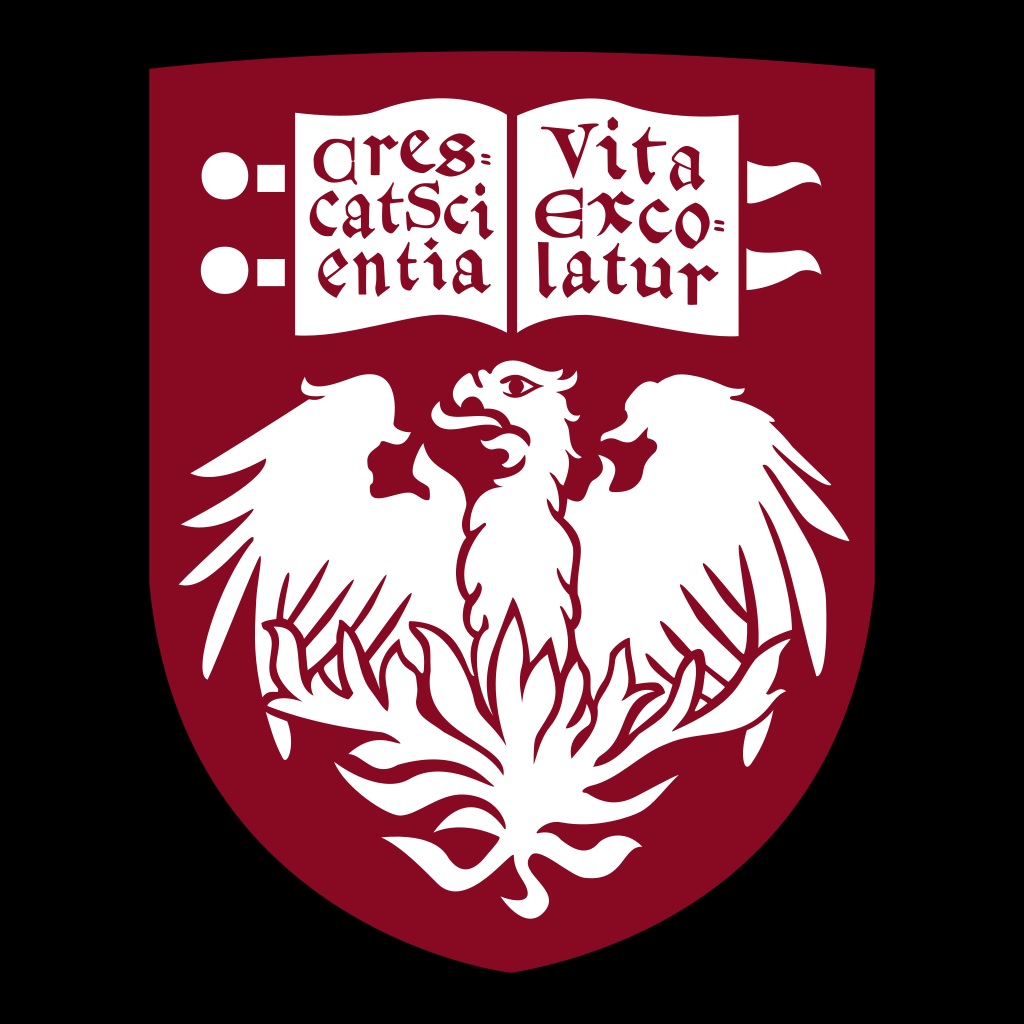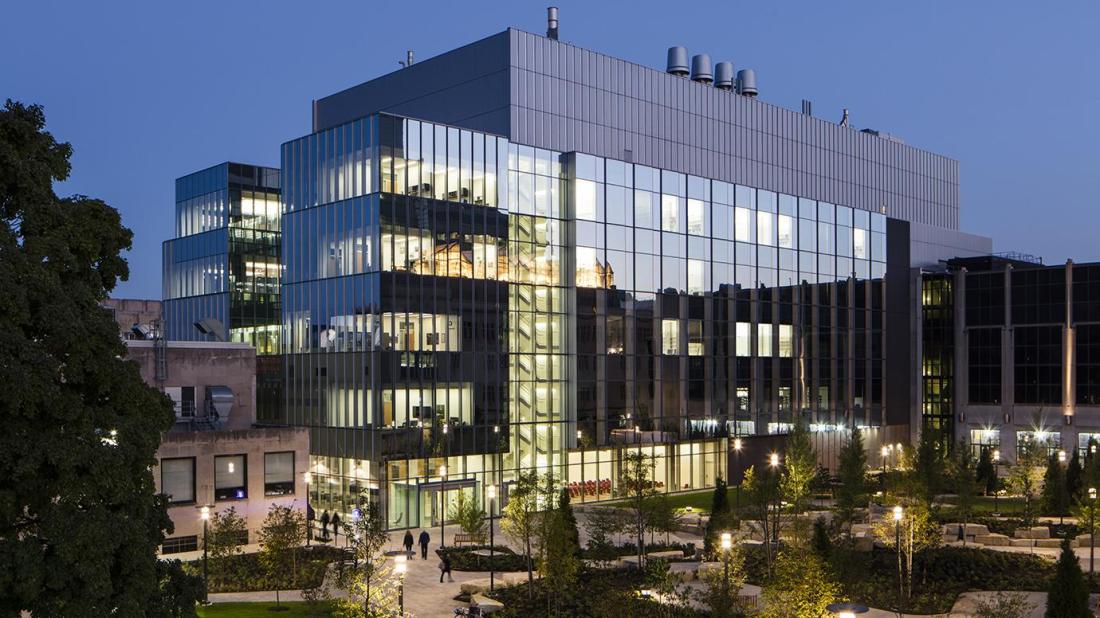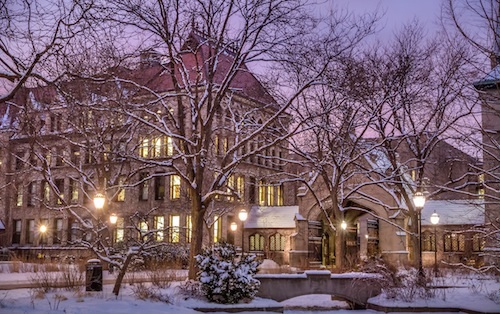From The Pritzker School of Molecular Engineering
At
5.21.24
Paul Dailing
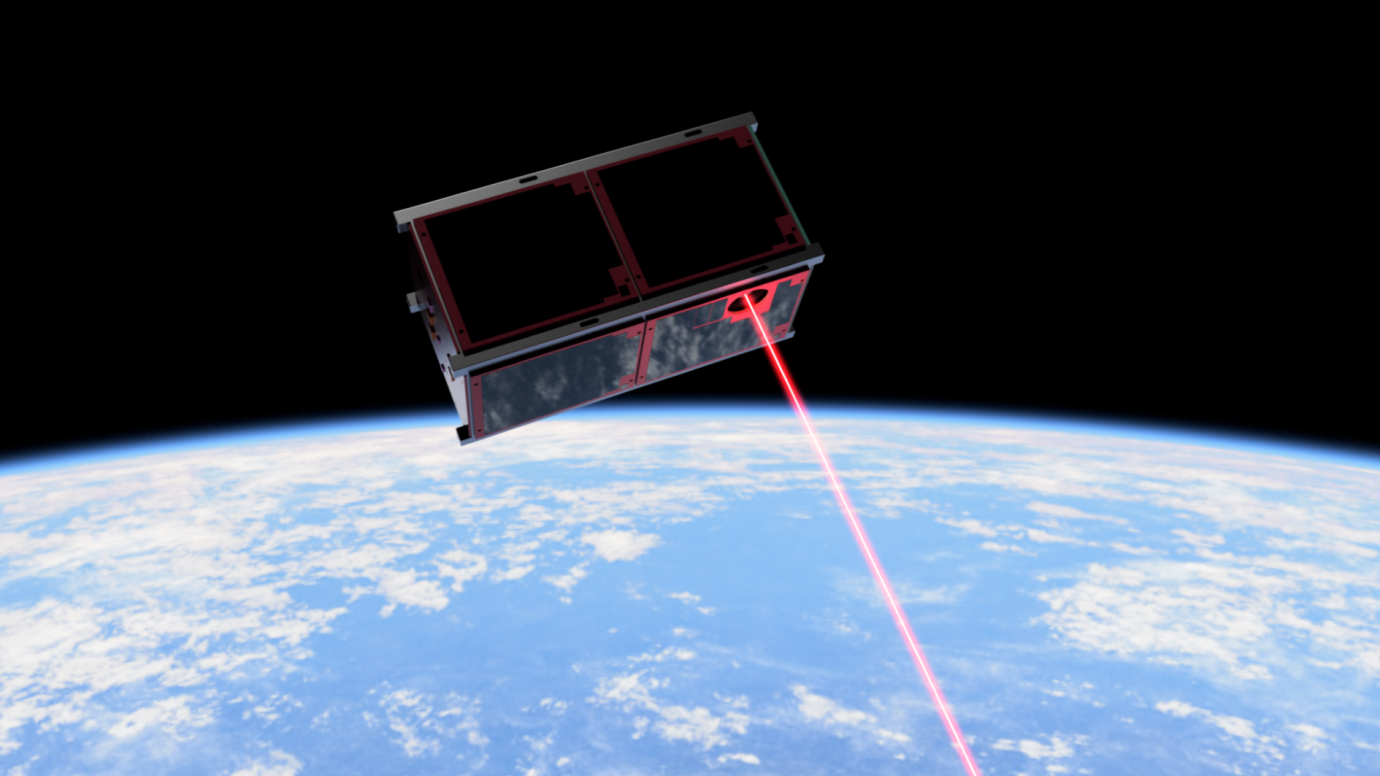
NASA has selected a 10x10x23 centimeter “CubeSat” designed by a team of UChicago graduates for launch in late summer 2026. The project aims to make space-to-ground operations more difficult to intercept and jam, while increasing the speed of communications. Above, a rendering of the satellite when launched. Rendering provided by PULSE-A.
Student-designed CubeSat aims to increase speed, security of space-to-ground communications
A team of more than 60 UChicago undergraduates is building a tiny satellite that will be launched into orbit courtesy of NASA’s CubeSat Launch Initiative.
While large satellites like the Hubble Space Telescope are the size of a bus and even “SmallSats” are the size of a refrigerator, CubeSats are a class of nanosatellites that can be as tiny as a 10-centimeter cube (roughly four inches).
But big science can come from these small devices. The UChicago team’s CubeSat aims to make space-to-ground operations more difficult to intercept and jam, while increasing the speed of communications.
“The project that we settled on was building a 10 megabit-per-second space-to-earth laser downlink,” said project director Lauren Ayala, a fourth-year student majoring in molecular engineering and astrophysics. “We want to take a signal on the satellite and then send it to an optical ground station on the Earth.”
The satellite, named PULSE-A (for Polarization modUlated Laser Satellite Experiment), was designed and will be built by a group of University of Chicago undergraduates from the Pritzker School of Molecular Engineering, the Physics Department, the Computer Science Department and the Department of Astronomy & Astrophysics.
Theirs was one of 10 projects from universities across the country selected in the most recent round of NASA’s CubeSat Launch Initiative. Since its inception in 2010, the program has launched more than 150 small research satellites into orbit, helping student-led projects explore the stars.
“We are constantly sending information to space with our phones. Space has become so accessible,” said Juan Ignacio Prieto, a first-year majoring in physics and philosophy and the head of the optical ground station that will receive PULSE-A’s communications. “But there’s something different about thinking how something you design and build is going to space.”
‘We have two and a half years’
In November, the students submitted an 80-page proposal to NASA outlining their plans for a 10x10x23 centimeter CubeSat capable of tackling this challenge in a way that’s both space-efficient and, by satellite standards, inexpensive. In March, NASA selected their project to be launched.
“We have two and a half years to take the design that we’ve been working on last year and fabricate it ourselves. And then we hand it over to NASA,” Ayala said.
NASA will only cover the cost of the launch. The team must build it on their own.
Pritzker School of Molecular Engineering Prof. Tian Zhong lent the team a portion of an optical table on which to fabricate the device. Other faculty have pledged to help with system requirement reviews and other advisement needed for such a massive project, the last bits of which must be done in a cleanroom.
For the students, it will be an intense and time-consuming learning process.
“It’s also very fun,” said PULSE-A Outreach Lead James Passmore, a second-year student. “I like to describe it as baking instructions. We spent the last year and a half writing the instructions. Now it’s time to bake the cake.”
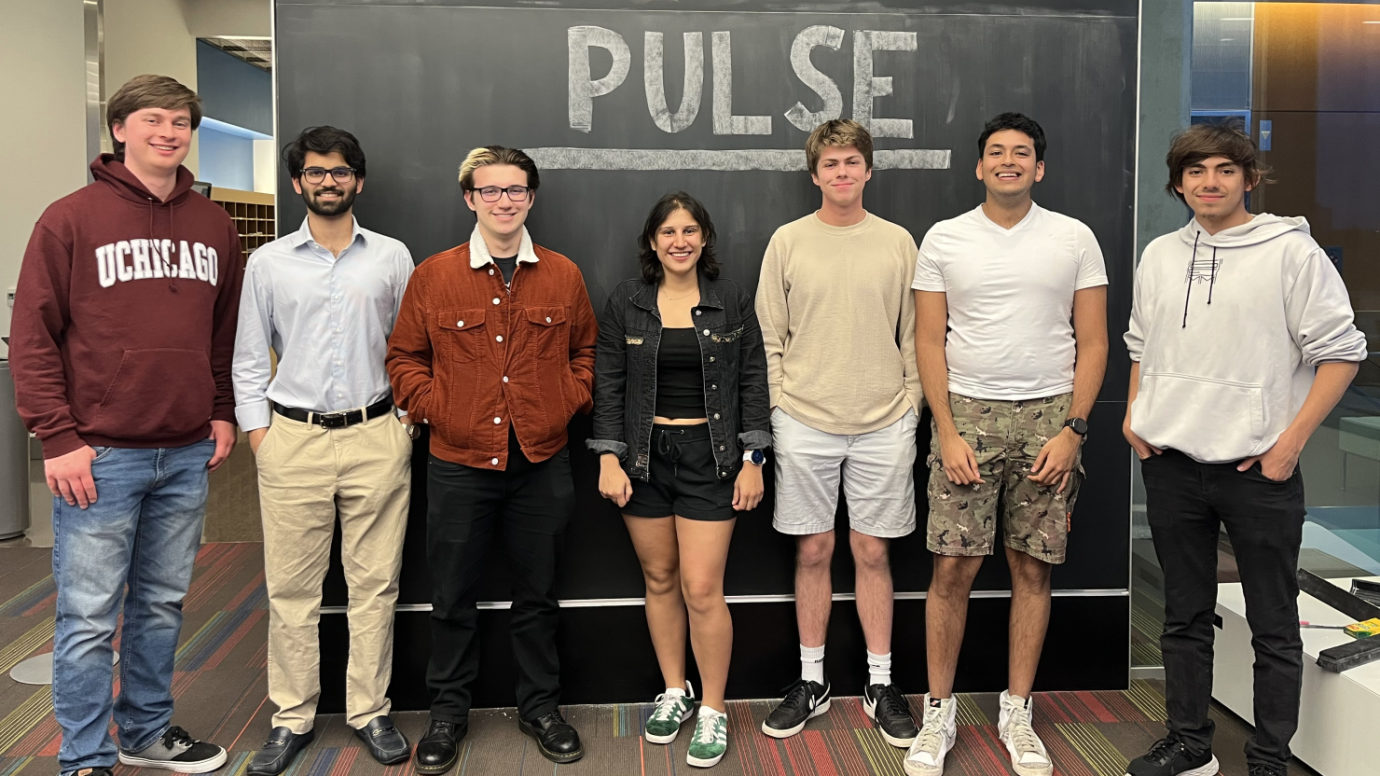
Members of the UChicago PULSE-A leadership team. From left, Astrophysics first-year John Baird; Mathematics and Computer Science first-year Parth Bhandari; Molecular Engineering and Astrophysics second-year Logan Hanssler; Molecular Engineering and Astrophysics fourth-year Lauren Ayala; Physics second-year Seth Knights; Astrophysics, Physics, and Computer Science fourth-year Rohan Gupta; and Physics and Philosophy first-year Juan Ignacio Prieto. Photo provided by PULSE-A.
A laser in space
The satellite will start with a laser in space that is modulated to encode data with left- and right-handed polarization. The data will travel 800 km to an optical ground station back on Earth.
Radio frequency has long been the typical approach for communications between earth and satellites; the UChicago team opted for lasers in part because of the additional security needed for a communications satellite, Ayala said.
“With lasers, you’re dealing with more directionality and you finish with less divergence. This means it’s a lot harder for people to listen and break your encryption,” she said. “Also, it’s a faster means of communication.”
UChicago’s PULSE-A project is expected to launch in late summer 2026.
Although the launch location won’t be announced until 8-12 months prior to launch, many past CubeSat projects have launched from the International Space Station.
“I had never seen them launch satellites off the ISS,” said Passmore. “I just saw it on my Instagram feed the other day and I thought, ‘It reminds me of Star Wars.’”
See the full article here .
Comments are invited and will be appreciated, especially if the reader finds any errors which I can correct.
five-ways-keep-your-child-safe-school-shootings
Please help promote STEM in your local schools.
The Pritzker School of Molecular Engineering is the first school of engineering at the University of Chicago. It was founded as the Institute for Molecular Engineering in 2011 by the university in partnership with the DOE’s Argonne National Laboratory. When the program was raised to the status of a school in 2019, it became the first school dedicated to molecular engineering in the United States. It is named for a major benefactor, the Pritzker Foundation.
The scientists, engineers, and students at PME use scientific research to pursue engineering solutions. The school does not have departments. Instead, it organizes its research around interdisciplinary “themes”: immuno-engineering, quantum engineering, autonomous materials, and water and energy. PME works toward technological advancements in areas of global importance, including sustainable energy and natural resources, immunotherapy-based approaches to cancer, “unhackable” communications networks, and a clean global water supply. The school plans to expand its research areas to address more issues of global importance.
IME was established in 2011, after three years of discussion and review. It was the largest academic program founded by the University of Chicago since 1988, when the Harris School of Public Policy Studies was established.
Matthew Tirrell was appointed founding Pritzker Director of IME in July 2011. The Pritzker Directorship honors the Pritzker Foundation, which donated a large gift in support of the institute. Tirrell is a researcher in biomolecular engineering and nanotechnology. His honors include election to The National Academy of Engineering, The American Academy of Arts and Sciences, and The National Academy of Sciences. He became dean of PME in 2019.
The William Eckhardt Research Center (WERC), which houses the school and part of the Physical Sciences Division, was constructed between 2011 and 2015. The WERC was named for alumnus William Eckhardt, in recognition of his donation to support scientific research at the university.
Faculty at the school have filed many invention disclosures and have created a number of companies.
On May 28, 2019, the University of Chicago announced a $100 million commitment from the Pritzker Foundation to support the institute’s transition to a school—the first school of molecular engineering in the U.S. The Pritzker Foundation helped establish the school with a new donation of $75 million, adding to an earlier $25 million donation that supported the institute and the construction of the Pritzker Nanofabrication Facility. In 2019, PME became the university’s first new school in three decades.
PME offers a graduate program in molecular engineering for both Master and Ph.D. students, as well as an undergraduate major and minor in molecular engineering offered with the College of the University of Chicago.
The institute began accepting applications to its doctoral program in fall 2013. The first class of graduate students was matriculated the following fall. In 2019, the school had 28 faculty members, 91 undergraduate students, 134 graduate students, and 75 postdoctoral fellows.
The graduate program curriculum includes various science and engineering disciplines, product design, entrepreneurship, and communication. The program is interdisciplinary, featuring a connected art program called STAGE Lab. STAGE Lab creates plays and films in the context of scientific research at PME.
The undergraduate major was added in spring 2015. It was the first engineering major offered at the University of Chicago. In 2018, the first undergraduate class received degrees in molecular engineering. When the school was established in 2019, it announced plans to expand its undergraduate offerings.
David Awschalom, a professor at PME, said the school has contributed to Chicago becoming a hub for quantum education and research. PME offers an advanced degree in quantum science and engineering. It also partnered with Harvard University to launch the Quantum Information Science and Engineering Network, a graduate student training program in quantum science and engineering. Participating students are paired with two mentors—one from academia and one from industry. The program was funded by a $1.6 million award from the National Science Foundation.
The school’s partnership with The DOE’s Argonne National Laboratory provides additional opportunities for research and innovation. Argonne’s facilities include the Advanced Photon Source, the Argonne Leadership Computing Facility, and the Center for Nanoscale Materials. The lab also has experience licensing new technology for industrial and commercial applications.
PME’s educational outreach initiatives include K-12 programs with events and internships throughout the year. In 2019, with the establishment of PME, the school also launched a partnership with City Colleges of Chicago. The multi-year program connects City College students interested in STEM fields with PME faculty and labs, with the goal of enabling these students to transfer into four-year STEM degree programs.
The University of Chicago is an urban research university that has driven new ways of thinking since 1890. Our commitment to free and open inquiry draws inspired scholars to our global campuses, where ideas are born that challenge and change the world.
We empower individuals to challenge conventional thinking in pursuit of original ideas. Students in the College develop critical, analytic, and writing skills in our rigorous, interdisciplinary core curriculum. Through graduate programs, students test their ideas with University of Chicago scholars, and become the next generation of leaders in academia, industry, nonprofits, and government.
University of Chicago research has led to such breakthroughs as discovering the link between cancer and genetics, establishing revolutionary theories of economics, and developing tools to produce reliably excellent urban schooling. We generate new insights for the benefit of present and future generations with our national and affiliated laboratories: the DOE’s Argonne National Laboratory, the DOE’s Fermi National Accelerator Laboratory , and the Marine Biological Laboratory in Woods Hole, Massachusetts.
The University of Chicago is enriched by the city we call home. In partnership with our neighbors, we invest in Chicago’s mid-South Side across such areas as health, education, economic growth, and the arts. Together with our medical center, we are the largest private employer on the South Side.
In all we do, we are driven to dig deeper, push further, and ask bigger questions—and to leverage our knowledge to enrich all human life. Our diverse and creative students and alumni drive innovation, lead international conversations, and make masterpieces. Alumni and faculty, lecturers and postdocs have gone on to become Nobel laureates, CEOs, university presidents, attorneys general, literary giants, and astronauts. The University of Chicago was founded in 1890. Its main campus is located in Chicago’s Hyde Park neighborhood. The University of Chicago is ranked among the top universities in the world by major education publications, and it is among the most selective in the United States.
The university is composed of one undergraduate college and five graduate research divisions, which contain all of the university’s graduate programs and interdisciplinary committees. Chicago has eight professional schools: the Law School, the Booth School of Business, the Pritzker School of Medicine, the School of Social Service Administration, the Harris School of Public Policy, the Divinity School, the Graham School of Continuing Liberal and Professional Studies, and the Pritzker School of Molecular Engineering. The university has additional campuses and centers in London, Paris, Beijing, Delhi, and Hong Kong, as well as in downtown Chicago.
University of Chicago scholars have played a major role in the development of many academic disciplines, including economics, law, literary criticism, mathematics, religion, sociology, and the behavioralism school of political science, establishing the Chicago schools in various fields. Chicago’s Metallurgical Laboratory produced the world’s first man-made, self-sustaining nuclear reaction in Chicago Pile-1 beneath the viewing stands of the university’s Stagg Field. Advances in chemistry led to the “radiocarbon revolution” in the carbon-14 dating of ancient life and objects. The university is also home to the University of Chicago Press, the largest university press in the United States. The Barack Obama Presidential Center is expected to be housed at the university and will include both the Obama presidential library and offices of the Obama Foundation.
The University of Chicago’s students, faculty, and staff have included many Nobel laureates. The university’s faculty members and alumni also include Fields Medalists, Turing Award winners, MacArthur Fellows, Marshall Scholars, Pulitzer Prize winners, National Humanities Medalists, living billionaire graduates, and a number of Olympic medal winners.
Research
The University of Chicago is classified among “R1: Doctoral Universities – Very high research activity” and is a founding member of the Association of American Universities and was a member of the Committee on Institutional Cooperation from 1946 through June 29, 2016, when the group’s name was changed to the Big Ten Academic Alliance. The University of Chicago is not a member of the rebranded consortium, but will continue to be a collaborator.
The university operates more than 140 research centers and institutes on campus. Among these are the Oriental Institute—a museum and research center for Near Eastern studies owned and operated by the university—and a number of National Resource Centers, including the Center for Middle Eastern Studies. Chicago also operates or is affiliated with several research institutions apart from the university proper. The university manages the DOE’s Argonne National Laboratory, part of the United States Department of Energy’s national laboratory system, and co-manages the DOE’s Fermi National Accelerator Laboratory, a nearby particle physics laboratory, as well as a stake in the the Apache Point Observatory in Sunspot, New Mexico.
______________________


______________________
Faculty and students at the adjacent Toyota Technological Institute at Chicago collaborate with the university. In 2013, the university formed an affiliation with the formerly independent Marine Biological Laboratory in Woods Hole, Mass. Although formally unrelated, the National Opinion Research Center is located on Chicago’s campus.

